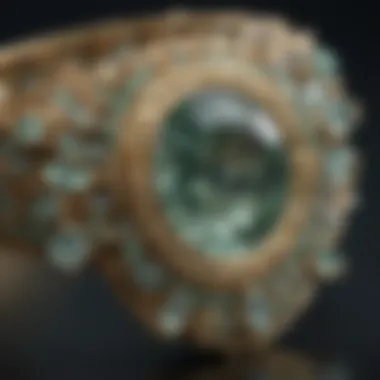Exploring the Unique Properties of Pale Green Crystals


Intro
Pale green crystals enchant those who seek knowledge about gemstones. Their beauty holds more than just aesthetic value; it encompasses unique properties and rich histories. This guide covers various aspects of pale green crystals, including their geological formations, cultural significance, and practical applications in jewelry and holistic practices.
Gemstone Overview
Description of the Gemstone
Pale green crystals generally refer to several minerals displaying this distinctive hue. Common examples include peridot, green aventurine, and serpentine. Each of these stones showcases variations in shade and structure, but they all share a common charm that attracts collectors and enthusiasts alike.
Physical Properties
Pale green gemstones come with different physical characteristics. The following are key properties:
- Hardness: Most pale green crystals rank from 6.5 to 7 on the Mohs scale, indicating a good level of durability.
- Transparency: These stones can vary from translucent to transparent, affecting their use in jewelry.
- Luster: The surface of pale green crystals may exhibit a vitreous or waxy luster, contributing to their visual appeal.
Healing Properties
Metaphysical Attributes
Many believe that pale green crystals offer various metaphysical benefits. They are often associated with tranquility, growth, and harmony. Several practitioners assert that these stones promote emotional balance and support personal growth. Their calming effects can create a serene atmosphere for meditation or healing practices.
Common Uses in Holistic Practices
Pale green crystals serve multiple purposes in holistic practices:
- Meditation: Used during meditation sessions, they help ground energies and enhance focus.
- Healing: Healers often place these stones on specific body areas to promote relaxation and alleviate stress.
- Jewelry: Many artisans incorporate pale green crystals in jewelry, creating pieces that not only look stunning but also embody healing properties.
"Pale green crystals serve both aesthetic and therapeutic roles in various cultures."
Pale green crystals exist not just as ornamental pieces but as significant tools in spiritual and mental well-being. Their classification, properties, and utility establish their importance in both ancient and contemporary contexts.
Foreword to Pale Green Crystals
The study of pale green crystals holds significant relevance in both geological and gemological contexts. These gems are not merely aesthetically appealing; they also present a wealth of information regarding their formation, classification, and applications. Understanding pale green crystals allows enthusiasts and professionals alike to appreciate their uniqueness and the stories they embody.
Pale green crystals exhibit characteristics that make them particularly sought after. Their hues can evoke emotions and convey meanings in various cultures. Furthermore, these crystals often serve distinct purposes in healing, jewelry making, and collectibles, highlighting their multifaceted nature. The variety of pale green minerals showcases the complexity of geological processes that yield such beautiful specimens.
Moreover, embracing knowledge about pale green crystals encourages deeper appreciation among collectors, designers, and mineralogists. Each type carries specific traits and benefits, impacting its classification and commercial use. By delving into the characteristics and significance of these gems, this article aims to enrich understanding and foster a more informed engagement with these natural wonders.
Definition and Characteristics
Pale green crystals are classified by their distinguishing color, which ranges from soft mint green to deeper shades. This unique coloration results from specific mineral compositions, reflecting their environmental origins. Common minerals like prehnite, green tourmaline, vesuvianite, and green fluorite are often identified within this category.
In terms of characteristics, pale green crystals can display transparency or translucency. Their clarity can determine the quality and value within the gemstone trade. Additionally, textures can vary from smooth and polished to rough and natural. Each form holds its own allure, attracting diverse audiences from casual admirers to serious collectors.
"The appeal of a pale green crystal goes beyond mere aesthetic value; it is a living piece of Earth’s history."
Significance in Gemstone Classification
The classification of pale green crystals within the broader spectrum of gemstones is critical for both commercial purposes and scientific research. Gemstone classification involves careful examination of physical properties, chemical compositions, and the environments in which these minerals form.
Understanding where pale green crystals fit within the gem hierarchy aids in identification and valuation. Gemologists categorize them based on clarity, cut, carat weight, and color. Color is particularly pivotal in this classification, as it often enhances a crystal's desirability and price point.
This classification system not only assists collectors in acquiring authentic specimens but also helps in promoting ethical sourcing practices. Knowledge of the origins and classifications enables purchasers to make decisions aligned with sustainable and responsible practices.


Common Types of Pale Green Crystals
The exploration of common types of pale green crystals reveals not only their aesthetic appeal but also their unique properties and the wide array of applications they offer. Each crystal embodies distinct characteristics that cater to various interests, from geological significance to their roles in spiritual traditions and craftsmanship. Understanding these variations enhances one’s appreciation for these valuable stones, whether for personal collection or practical use in jewelry design.
Prehnite
Prehnite, with its delicate pale green hue, is a popular choice among collectors and jewelers alike. Characterized by its translucent appearance and often found alongside other minerals such as Quartz, Prehnite is considered a stone of unconditional love.
- Mineral Composition: Prehnite is primarily composed of calcium and aluminum silicate, contributing to its attractive visual clarity and strength. Its unique composition allows light to play beautifully across its surface, enhancing its value.
- Applications: In jewelry making, Prehnite is often cut into cabochons or beads, sought for both its beauty and connectivity to emotional healing practices. Many believe that it can promote peace and calmness, making it a desired piece in meditation jewelry.
Green Tourmaline
Green Tourmaline is among the most esteemed gemstones in the pale green spectrum. Its rich color can vary from light, almost minty greens to deeper, more forest-like shades.
- Optical Properties: Tourmaline exhibits pleochroism, which causes it to display different colors when viewed from different angles. This feature adds to its allure, making every piece unique.
- Uses: Jewelers favor Green Tourmaline for its durability and beautiful shades. It is also known to be a stone of abundance, believed to promote prosperity and wealth.
Vesuvianite
Vesuvianite, also known as Idocrase, presents a fascinating color spectrum including pale green. Its unique crystalline structure and occasionally fibrous appearance make it stand out in any collection.
- Formation: This stone forms in metamorphic rock under high-pressure conditions. Its formation processes contribute to its rarity and distinct characteristics, drawing the interest of geology enthusiasts.
- Cultural Significance: While not as widely recognized as other gemstones, Vesuvianite is cherished for its history and the stories attached to its discovery, particularly in Italy’s Mount Vesuvius area.
Green Fluorite
Green Fluorite exhibits a transparent, pale green quality that makes it a popular choice in both decorative items and jewelry.
- Chemical Composition: Composed of calcium fluoride, the crystal has a distinctive cube shape, often found in various sizes. The clarity and brilliance make it suitable for intricate cut designs.
- Properties: Green Fluorite is revered in many cultures for its supposed ability to cleanse negative energies. It is often sought after by those who value its purifying qualities, making it a staple in healing practices and spiritual settings.
Geological Formation of Pale Green Crystals
Understanding the geological formation of pale green crystals provides insight into their characteristics and value. This section explores the essential components of their formation, including mineral makeup, processes involved in their creation, and the locations from which they originate. Knowledge in this area is relevant for gemstone enthusiasts, collectors, and jewelry designers, helping them appreciate the uniqueness of these crystals.
Mineral Composition
The mineral composition of pale green crystals is crucial in determining their color, clarity, and overall appearance. Common minerals found in these crystals include:
- Epidote: Known for its green hues and distinctive banding, epidote often contributes to the vibrant colors seen in certain pale green varieties.
- Serpentine: This mineral can create a softer green shade, often found in decorative stones.
- Chlorite: Sometimes mixed with other minerals, chlorite can impart a rich green color.
- Fluorite: Known for its fluorescence, fluorite can exhibit a pale green color, popular in gemstone collections.
The combination of these minerals results in the diverse range of pale green crystals seen across different types. Each mineral adds distinct properties, enhancing the desirability of the crystals for various uses.
Formation Processes
The formation of pale green crystals often occurs through a combination of geological processes over extended periods. Key processes include:
- Igneous processes: As magma cools, minerals crystallize, leading to the formation of various crystal structures. Crystals like olivine can form in volcanic rock.
- Metamorphism: The alteration of existing rocks under heat and pressure can result in new mineral formations. This process can lead to the development of epidote or garnet, both of which can exhibit pale green colors.
- Sedimentary processes: Weathering of rocks and minerals can lead to the deposition of materials that ultimately crystallize into pale green stones. This includes the action of water transporting minerals to settle in layers.
Each formation process contributes to the specific characteristics of pale green crystals, influencing their quality and appearance.
Geological Locations
Pale green crystals can be found in various geological locations worldwide, influenced by the formation processes present in those areas. Some notable sources include:
- Brazil: Brazilian deposits often yield spectacular specimens of green tourmaline.
- Madagascar: Known for its rich mineral diversity, Madagascar produces a variety of pale green stones like prehnite.
- USA: States like California and Arkansas feature diverse geological activities, resulting in unique pale green crystals, particularly quartz varieties.
- South Africa: This region is noted for its extensive mining operations, unearthing a vast range of green minerals.
The geological settings of these regions provide a window into the environmental conditions that foster the growth of pale green crystals. Learning about these locations can enrich one’s knowledge when selecting or collecting these stones.
Industrial and Commercial Uses


Pale green crystals play important roles in various industries. Their unique properties make them desirable for jewelry making, decorative items, and collectibles. This section will explore the significance of each of these uses.
Jewelry Making
Jewelry making is one of the most prominent applications of pale green crystals. Stones like Prehnite and Green Fluorite are highly regarded for their aesthetic appeal. Designers utilize these crystals to create beautiful necklaces, rings, earrings, and bracelets. The gentle hue of pale green complements many styles and can be paired with different metals such as gold or silver.
The demand for unique jewelry pieces has risen. Many consumers seek out distinct gemstones to express individuality. As such, the use of pale green crystals is increasing. They offer both elegance and charm, making them favorites among jewelry designers and enthusiasts alike. Additionally, their relative rarity can enhance the value of the pieces created from them.
Decorative Items
Pale green crystals are also used in decorative items. Home decor is a growing market. Crystals can be crafted into vases, sculptures, and various ornaments. The soft green color provides a calming effect, suitable for settings like homes and offices. Many people believe these crystals enhance the aesthetic appeal of spaces, providing both beauty and tranquility.
Moreover, the popularity of using crystals in home decor has risen due to trends in natural and holistic living. People are drawn to the idea of incorporating elements from nature into their environments. Pale green crystals fit well within this concept, leading to a thriving market in decorative applications.
Collectibles
For collectors, pale green crystals hold significant value. Collectors often seek rare and unique specimens to enhance their collections. Species like Green Tourmaline and Vesuvianite are highly prized by enthusiasts. The value of these stones can increase depending on factors such as quality, size, and uniqueness.
Many collectors appreciate the stories behind each specimen. Some pay attention to mining locations or the geological history of specific stones. Documentation can additionally enhance the collectible value. This aspect creates a vibrant market among both new and seasoned collectors.
Collecting pale green crystals offers both personal satisfaction and potential financial benefits.
In summary, the industrial and commercial uses of pale green crystals are vast and varied. From stunning jewelry pieces to decorative home items, and collectible specimens, these crystals hold significant importance in the market. The growing interest in natural aesthetics ensures they remain relevant and sought after.
Metaphysical Properties and Healing Benefits
The metaphysical properties of pale green crystals have long fascinated enthusiasts, collectors, and practitioners alike. These stones are often associated with specific energies and frequencies that are believed to promote various aspects of well-being. By integrating both spiritual and practical insights, we can gain a clearer understanding of the role these crystals play in healing and personal growth.
Spiritual Significance
Pale green crystals are thought to resonate with the heart chakra, promoting love, compassion, and emotional balance. Their soothing colors are believed to invite tranquility and harmony into one’s life. Many seekers turn to these crystals for spiritual alignment, often using them in meditation or cleansing rituals.
The spiritual significance of these stones can be seen in various practices. Some individuals utilize pale green crystals during chakra healing sessions. When placed on the body, they are said to help remove energy blockages, facilitating a smoother flow of life force energy. This allows practitioners to connect more deeply with their inner selves, fostering a sense of attachment to a greater universal consciousness.
Emotional Healing
Pale green crystals hold a notable place in emotional healing. Their calming presence is often cited as beneficial for alleviating stress and anxiety. By fostering a nurturing energy, these stones can help individuals confront and process past traumas, promoting emotional growth and resilience.
In practice, many people carry these crystals as talismans during challenging times. They are also placed in living spaces to elevate the energy and create an atmosphere of support and comfort. This practice is rooted in the idea that the environment affects emotions and well-being. The gentle vibrations of these crystals can serve as reminders to embrace self-love and acceptance.
"Carrying a pale green crystal can be a simple yet impactful way to enhance emotional stability and peace."
Physical Benefits
While the scientific community remains wary of metaphysical claims, many advocates report positive physical benefits. Pale green crystals are said to support healing processes, especially those related to the heart and lungs. Some believe that wearing these stones can assist in strengthening the circulatory system and improving overall wellness.
Additionally, these crystals are often used in holistic therapies aimed at detoxication. Many suggest pairing pale green stones with other healing modalities, such as herbal treatments or energy work, to amplify their effects. This integrative approach emphasizes a harmonious blend of mental, emotional, and physical health, aligning with the principles of holistic healing.
In summary, the metaphysical properties and healing benefits of pale green crystals offer a rich field for exploration and application. Whether used for spiritual alignment, emotional support, or physical well-being, these stones can serve as valuable tools in personal development.
Cultural Significance of Pale Green Crystals
The cultural significance of pale green crystals spans various regions and time periods. These gemstones hold a history that reflects human connection with nature and a deeper understanding of spirituality. From ancient civilizations to modern philosophies, pale green crystals have played a prominent role in rituals, art, and belief systems. Exploring their historical uses, modern interpretations, and cultural integrations provides insight into their lasting impact.
Historical Uses
Historically, pale green crystals were utilized in numerous ways. Ancient Egyptians carved these stones into amulets and ornaments, believing they possessed protective powers. They thought these crystals could ward off evil spirits and bring good fortune. Similarly, in ancient Chinese culture, jade, particularly in pale green shades, was revered. It symbolized purity and moral integrity. People used it in burial practices, ensuring that the deceased carried these qualities into the afterlife.


In some Native American traditions, pale green stones were often used in medicine. They were seen as tools for healing both physical and emotional ailments. Shamans and healers would utilize these crystals during rituals to promote balance and harmony. The repeated use of these stones in different cultures emphasizes their importance across time.
Modern Interpretation
In contemporary society, the interpretation of pale green crystals has evolved but remains deeply connected to their historical roots. Today, these stones are often viewed through the lens of metaphysical practices. Many believe they offer calming energies, aiding in emotional balance and stress relief. They are frequently included in meditation practices, promoting tranquility and mental clarity.
Furthermore, the rising interest in natural and holistic wellness has increased the popularity of pale green crystals in alternative healing. People often use them in crystal grids or carry them in pockets for daily energy support.
Cultural Integrations
Pale green crystals have found a place in various cultural frameworks. In some modern spiritual communities, they are regarded as symbols of growth and renewal. Many associate them with personal development and the pursuit of goals. This is especially significant in cultures that emphasize wellness, mindfulness, and self-improvement.
Artisans have also integrated pale green crystals into modern jewelry. Designers often utilize these stones to create pieces that resonate with consumers who value both aesthetics and symbolic meanings. This trend underscores a blend of ancient beliefs with contemporary fashion, illustrating how cultural significance can transcend generations.
"Pale green crystals serve as a bridge between historical wisdom and modern insight, reminding us of our intricate connection to the earth."
Sustainability and Ethical Considerations
The growing awareness about environmental impact and ethical responsibilities has led to a significant focus on sustainability within the gemstone industry. This concern is particularly pertinent for pale green crystals, whose mining and trade practices can have profound effects on local environments and communities. The need for sustainable practices is not merely a trend; it reflects a deeper acknowledgment of our shared responsibility to safeguard the planet while also respecting human rights across the entire supply chain.
Mining Practices
Mining practices vary across different industries, but the extraction of pale green crystals often involves methods that can disrupt ecosystems. Many of these stones, like Prehnite and Green Tourmaline, are sourced from both open-pit and underground mines. Each method has specific environmental implications. Open-pit mining can lead to significant deforestation and habitat destruction, while underground mining may cause ground subsidence and pollution of groundwater supplies.
To address these issues, there is an increasing push for the adoption of more responsible mining practices. Techniques such as selective mining and utilizing less invasive methods can minimize damage to surrounding land. Moreover, implementing modern technology can help in monitoring environmental impact. For instance, drone technology is increasingly employed to assess and mitigate the ecological effects of mining operations.
"Sustainability in gemstone mining is crucial not just for the environment but also for the communities that depend on these resources for their livelihoods."
Ethical Sourcing
Alongside sustainable mining practices, the focus on ethical sourcing plays a critical role in how pale green crystals are acquired and traded. Ethical sourcing involves ensuring that gemstones are mined in conditions that are safe for workers, free from exploitation, and do not contribute to conflict or environmental degradation.
Consumers are becoming increasingly vigilant; they prefer to purchase stones that are certified as ethically sourced. Organizations like the Responsible Jewelry Council set standards for ethical practices in this industry. By avoiding sourcing from regions plagued by conflict or labor exploitation, buyers support a marketplace that values human dignity and environmental integrity.
The traceability of materials is also a key component of ethical sourcing. Modern technologies, such as blockchain, are beginning to be applied in the gemstones sector, providing transparency in the supply chain. This allows consumers to trace their purchases back to the source, ensuring that their stones are ethically mined and conflict-free.
Culmination
The concluding section serves as a vital component of this exploration into pale green crystals. It synthesizes the insights gleaned from the various discussions presented throughout the article. This summary not only recaps the essential characteristics and classifications of pale green crystals but also emphasizes their multifaceted roles in jewelry, healing, and cultural significance.
Understanding pale green crystals encompasses knowledge of their geological formation, industrial uses, and ethical considerations associated with their sourcing. For enthusiasts and professionals alike, recognizing the importance of these elements enhances appreciation for these unique gemstones.
Key Points:
- Pale green crystals are not merely decorative objects; they embody unique physical properties and metaphysical significance.
- Their historical and modern cultural significance highlights the ongoing relevance of these stones.
- Sustainable practices reflect a growing awareness of ethical concerns in gemstone acquisition.
This conclusion not only highlights the depth and breadth of the content discussed but also serves as a primer for further exploration in the world of gemstones.
Summary of Key Insights
The article provides several important insights regarding pale green crystals:
- They are composed of various minerals, which influence their color, clarity, and value.
- Each type of pale green crystal has distinct properties that can affect their uses and meanings in different cultures.
- Their historical significance underlines the long-standing human fascination with these stones, pointing to their virtues as tools for healing and expression.
Furthermore, the applications of pale green crystals in jewelry-making and as decorative items reflect a balance of aesthetic appeal and intrinsic value. Beyond their physical beauty, these stones are ascribed with emotional and physical healing benefits, which add another layer of significance.
Future Exploration of Pale Green Crystals
Looking ahead, the exploration of pale green crystals promises numerous avenues for research and enthusiasm. Future investigations may focus on:
- Innovations in ethical mining practices that ensure sustainability and protection of the environment.
- Advancements in technology that improve the authenticity and sourcing transparency of gemstones.
- Cultural research that evaluates the evolving meanings of these crystals in different societies.
- The potential of pale green crystals in modern therapeutic practices, especially in alternative medicine.
This forward-looking perspective not only fuels curiosity among gemstone enthusiasts but also invites them to consider their roles in a changing world. As pale green crystals continue to enchant people globally, their multifaceted applications and implications remain ripe for exploration.







